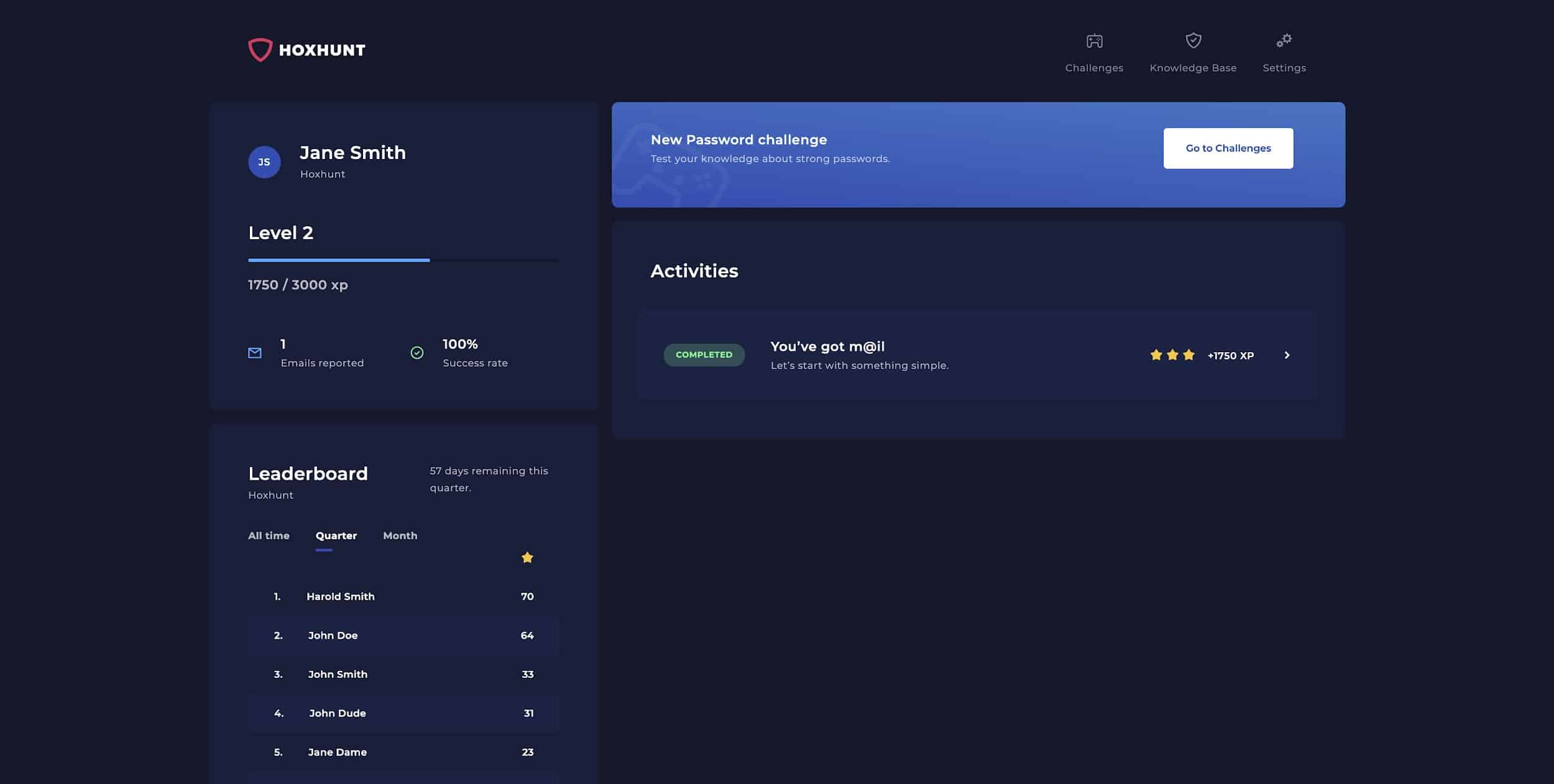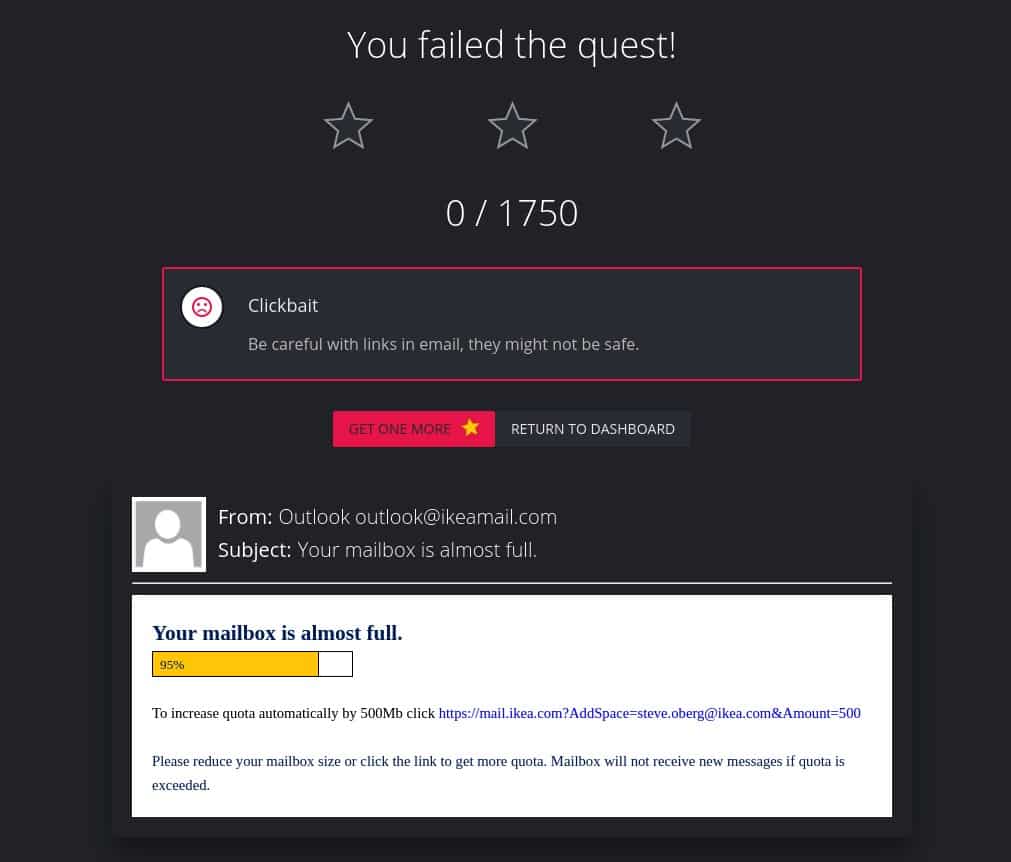Your company’s phishing defenses are only as strong as your weakest and least-educated employee. It just takes one naive worker new to phishing emails to innocently respond to something that looked genuine, and all your expensive cybersecurity systems are powerless.
Phishing simulations combat phishing scams
Phishing emails are becoming increasingly sophisticated, and it can be very difficult to distinguish between a genuine email and one that’s a front for a cyberattack. Even experienced employees have fallen for emails that ask them to reveal credentials to access sensitive data, share passwords for company assets, or send payments directly to the fraudsters.
Phishing simulations combat phishing scamsIncrease engagement with gamificationEducate every employee at every levelEase the process of reporting phishing attemptsRaise employee cybersecurity knowledge levelsImprove risk assessment accuracyEducated employees are the only defense against phishing attacks
The road to combating phishing threats, then, goes through employee education. Security teams use simulated phishing emails for training employees to spot the often subtle signs of a fake email. Simulations have been found to be more effective than workshops, seminars, or other educational tactics because they are more interactive. However, most phishing simulation programs aren’t fully effective. They deliver standardized training emails that don’t distinguish between less and more experienced users, with the result that experienced employees become frustrated by basic level instruction, while those who are less skilled risk getting overwhelmed by exercises that are beyond their level. In contrast, Hoxhunt’s software uses machine learning together with gamification to provide personalized training programs for each individual, making it a superior solution. Here are five ways that Hoxhunt’s approach to phishing education can protect your company from phishing scams. The best phishing education program in the world won’t do any good if your employees ignore it. Hoxhunt understands that, which is why the entire process of recognizing and reporting phishing emails is fully gamified.
The dashboard encourages users to advance their cybersecurity skills and knowledge by offering gamified tasks and challenges. Whenever employees successfully identify threats, the system awards them with stars, which appear on an organization-wide leaderboard that fosters an atmosphere of friendly competition and rivalry. Once a user connects to the Hoxhunt platform, they’ll begin receiving personalized phishing messages. Hoxhunt tracks each user’s responses, checking to see if the employee recognizes and flags suspicious emails correctly. Employees who succeed are sent emails of increasing sophistication, continually pushing their ability to detect fraudulent messages. For novices who don’t flag simulated phishing emails, Hoxhunt triggers a training program to educate them about that phishing attempt and to prepare them to recognize similar emails in the future. It will send these employees more training emails overall, beginning with simulations of the same complexity and gradually raising the employee’s ability to detect and respond to phishing scams. By personalizing the training experience, Hoxhunt helps employees at all levels to boost their phishing awareness. Experienced users won’t get frustrated and bored by simple simulations, and beginners won’t be overwhelmed or confused by training emails that are too advanced. You’ll generate a high level of phishing awareness, with each employee moving at their own pace. In most organizations, reporting suspicious emails is tedious and time-consuming. Employees have to get in contact with the service desk, save the suspicious email as an attachment, and finally to submit the whole thing to the security team. It’s a serious interruption to their work rhythms, reducing overall productivity and increasing employee irritation, leading to a low reporting rate for fraudulent emails. With Hoxhunt, users enjoy a one-click path to report suspicious emails. Every employee has a Hoxhunt button in their email client. Clicking that button notifies the response team, while simultaneously sending feedback to the employee that acknowledges their report. Employees who report a Hoxhunt-generated simulation get rewards on the platform. When they see a simulated phishing email, they receive feedback about the threat they identified – or that they failed to identify.
By making it easy to report suspicious emails, Hoxhunt increases the chances of employees acting on the threats they notice. Alongside training employees to identify sophisticated phishing emails, Hoxhunt delivers valuable cybersecurity information to each user, breaking it up into bite-size chunks. This micro-training appears every time a user reports a simulated email, making the learning process smooth and painless. By adding extra insights into cybersecurity issues and trends, Hoxhunt helps your employees to raise their knowledge and awareness about security threats on an ongoing basis, without cutting into their work time. As well as increasing risk reporting rates among employees, Hoxhunt helps security teams to make sense of the information they receive. The Hoxhunt incident response module groups and categorizes emails according to priority, and generates threat reports to provide real-time visibility into your organization’s phishing risk level.
When a phishing attack comes along, you can instantly see the size and scope of the attack across your organization, so that you can plan the appropriate response. Hoxhunt plugs your organization into a worldwide threat detection community, so that your security teams always know about the latest threats.
Educated employees are the only defense against phishing attacks
By using micro-learning, gamification, and machine learning, Hoxhunt trains your employees to continually improve their cybersecurity knowledge and threat awareness. Together with a one-click reporting process and advanced risk assessment tools, Hoxhunt prepares your organization to defend itself against phishing attacks in the only way that’s effective – through an alert and educated workforce.


